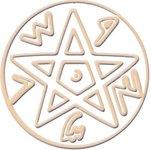Curator: Gila Hurvitz
The Max and Iris Stern Gallery, Mount Scopus, June 2000
The archaeological remains from Jericho during the Hasmonean period were uncovered by the late Professor Ehud Netzer on behalf of the Institute of Archaeology of the Hebrew University, the Israel Exploration Society, and the Archaeological Staff Officer of the Civil Administration for Judaea and Samaria.
The finds from the area, presented in this exhibition, provided a clear and detailed picture of the expansive royal Hasmonean estate that boasted winter palaces, swimming pools, and other installations.
The Hasmonean revolt was the only Jewish rebellion against Greco-Roman rule that ended in a victory and was realized by the establishment of an independent Jewish kingdom. The artifacts from this era exhibit Jewish content and symbols alongside Greek elements adopted from the wider Hellenistic world, which together reflect the Hasmoneans' desire to enjoy the best of both worlds.
One extraordinary and especially interesting find was a ritual bath (miqveh) exposed in John Hyrcanus I's palace. In contrast to the swimming pools and pavilion, which were built in the finest of Greek tradition, the ritual baths were built according to stringent halakhic rules reflecting the obligation of the Hasmonean priests to observe the laws of ritual purity.
The Hasmoneans' coins bear the names of only four rulers-Yehohanan, Judah, Jonathan/Alexander, and Mattathias/Antigonus. Whereas Hellenistic coins depicted their rulers' portraits, Hasmonean coinage refrained from displaying figural images owing to the strict interpretation of the biblical Second Commandment prohibiting their use (Exod. 20:4).
Hasmonean coins thus bore Jewish symbols, such as a pair of cornucopiae with a pomegranate between them surrounded by a wreath, in all probability meant to replace the bust of a ruler.
The coins of Mattathias Antigonus, the last Hasmonean king (40-37 BCE), contain the first visual evidence of the seven-branched menorah. It initially symbolized the Jerusalem Temple, but after its destruction in 70 CE the menorah lost much of its significance as a ritual object and was perceived as a symbol of national import identified with the Jewish people.
Scrolls found in the Qumran caves were also on display, providing a wealth of information about the views held by the sect then living in the Judaean Desert. Its members composed pesharim, contemporary interpretations of various biblical verses that also allude to historical events and key figures from this period, such as John Hyrcanus I (134-104 BCE), who built the agricultural farm and first palace in Jericho. The exhibition also featured fragments of the "Prayer for the Welfare of King Jonathan" and "Testimonia" scrolls found in Qumran, which also referred to Hasmonean rulers.

